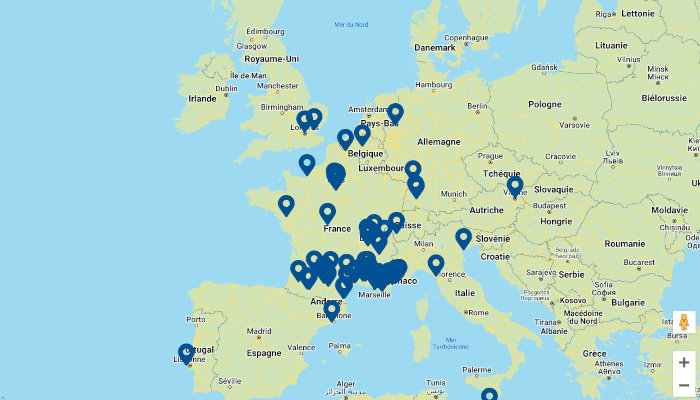Ceiling fans and summer comfort: back in favour (RE2020)
Overseas France is an asset.
This is undoubtedly the view of the many players, design offices, architects, installers and contractors who in recent years have put ceiling fans back in the limelight in places as varied as the Montaigne media library in Frontignan, the offices of Air Liquide, crèches in Lyon and the Occitanie region, schools in Grenoble, Marseille, Orange, Toulouse, etc., town halls and numerous municipal buildings or restaurants such as the Réciproque in Paris, etc.
Indeed, it is more from our overseas territories than from Asia, where ceiling fans have been a cultural element for many years, that the Ceiling fans have returned to conquer Metropolitan France.
Montaigne media library in Frontignan, equipped with Ceiling fans – Source: Tautem Architecture, photographer Luc Boegly
Ilet du Centre: innovation on all levels
We are in 2005, in Saint-Pierre de La Réunion.
A new type of premises has just been inaugurated. It is a mixed space of offices and housing, named by its designers « Ilet du Centre ».
This place is located in one of the hottest spots in the city, and it is the middle of the southern summer. When you walk through the door of the offices, designed by Antoine Perrau and Michel Reynaud, you notice a strange phenomenon: it is much warmer inside than outside. Yet there is no trace of air conditioning.
In fact, a range of good bioclimatic practices have been put to music:
- Ceiling fans, which give that pleasant feeling of freshness,
- through-ventilation, with window frames with pivoting glass slats, or louvres (the famous “Naco”),
- large roof overhangs (photovoltaic, needless to say), which allow shading of facades exposed to direct sunlight,
- external curtain of plants (“thermal buffer”), which cool naturally by evapo-transpiration,
- rainwater harvesting directly back to the garden,
- at the computer level, all the central units are grouped together in a dedicated room, outside the workspace, and linked to each of the workstations (screen-keyboard-mouse) by ultra-fast wired connections, to avoid overheating linked to the computer equipment.
The result is impressive, and it has been demonstrated that it is possible to work in a tropical environment without air conditioning.
The University of La Réunion at the forefront of Ceiling fans
At the same time, François Garde, a university professor and author of numerous works that have brought air blowers back into the limelight, showed, at the IUT in Saint-Pierre, to what extent the combination of air blowers and air conditioning also has significant advantages. The use of air mixers alone avoids the need for air conditioning in mid-season.
In the hot season, air mixers, in combination with air conditioning, allow the temperature set point to be increased. In this way, the energy consumption of the air conditioning is greatly reduced.
To cool a small room of 13 m², you need about 1500 W of power if you use a cooling unit. A ceiling fan, on the other hand, will consume about 50 W, i.e. thirty times less power, and a corresponding reduction in consumption.
Givoni: a revolutionary diagram
The work of architect Baruch Givoni, who created the bioclimatic diagram for the building, is at the root of this revival of the Ceiling fans.
The diagram he drew shows that the thermal comfort felt depends mainly on three parameters: temperature, humidity and air speed.
Therefore, rather than acting on the temperature through air conditioning, it becomes clear that increasing the air speed will make the occupants of a room feel better.
Bioclimatic diagram of the building: Boundaries of the thermal comfort zone (pink), the zone of influence of ventilation at 0.5m/s (VV’ orange) and thermal inertia (MM’ green), the zone of influence of evaporative cooling (EC and EC’ grey), the zone of non-heating by the passive solar design (H and H’ yellow) Source: Jean-Louis Izard & Olivier Kaçala
Empirically, everyone could see this. Without going back to ancient Egypt, fans had played a role in improving people’s comfort.
With Givoni’s work, we change the register, with more objective data, even if we talk about perceived comfort.
Thus, by increasing the air speed, the temperature gain can be up to 4 degrees.
From overseas to metropolitan France
In mainland France, with the help of intermediaries such as Robert Célaire, associations specialising in sustainable building such as EnvirobatBDM, E dans l’AU or Envirobat Occitanie are relaying and popularising this bioclimatic diagram.
Other players, such as the Tribu consultancy, in conjunction with the ICEB (Institut pour la Conception Ecoresponsable du Bâti), are also taking these achievements on board.
The result is a new diagram, particularly successful and explicit, which shows the extension of the comfort zone with the air speed. At equivalent temperature and humidity, the presence of an air speed between 0.5 and 1.5 m/s improves the temperature felt by people exposed to this air flow.
Bioclimatic diagram (Tribu Energie / ICEB)
The ceiling fans: soon in every building in the city?
As summer thermal discomfort is an increasingly important issue in metropolitan France, particularly since the heat wave of 2003, the government has taken a close interest in ceiling fans. As a result, ceiling fans appeared for the first time in an environmental regulation as part of the energy-carbon label, at the end of the 2010s.
And now, a real revolution is about to take place, with the inclusion of ceiling fans in the new environmental building regulations, the RE2020. From now on, the question will no longer be “should ceiling fans be used”, but rather “which ceiling fans should I choose”?

In Zone H3/H2D (Mediterranean arc), ceiling fans are essential for summer comfort in order to meet the requirements of the RE2020.

Exhale the first vortex bladeless ceiling fan
You are a professional. A specific space is dedicated to you.
Find Exhale Fans Europe on Linkedin
Did you like this article? Read the article RE2020 and ceiling fans: summer comfort as an objective





